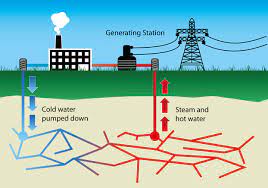COURTESY : www.esi-africa.com/
Geothermal and wind energy
Gordon Kihalangwa, Principal Secretary for the Ministry of Energy, said the development was supported by geothermal and wind power expansion programmes undertaken by Kenya Electricity Generating Company (KenGen) and other private sector players.
Kihalangwa also said it was imperative for energy sector stakeholders to undertake a SWOT analysis of the sector to enable them to identify threats, challenges and available opportunities facing the sector so as to propose holistic plans that took into consideration the emerging issues.
Geothermal is the leading contributor of power to the national grid, accounting for 44.12% followed by hydropower at 26.98%. Thermal is below 13%. KenGen contributes 26MW to the national grid from its wind power plant in Ngong hills.
Have you read?
These figures are in contrast to 2014 when the share of thermal power was at a high of 34.49% due to erratic rains that reduced hydropower sources.
“The government and its development partners have increased investments in green energy development to help diversify baseload renewable electricity supply in the country and reduce in greenhouse gas emissions occasioned by fossil-fuel-based alternatives,” noted Kihalangwa.
Other green energy power plants under development in Kenya, include the 300MW Lake Turkana Wind Power Plant, which is the single largest wind power plant in Africa, the 70MW Olkaria 1 and the 140MW Olkaria V.
“We are focused on achieving our targeted installed power generation capacity– mostly from green sources– to 3,500MW by 2025. Kenya plans to increase the installed power capacity to about 17,760MW by 2030; with geothermal expected to contribute about 7,000MW,” he explained.
Capital FM reports that according to the Principal Secretary the number of households connected to electricity in the country increased by 1,452,984 households which he stated points to the fruits of the State’s last-mile connectivity programme which was launched in 2014 mainly targeting rural areas.
Have you read?
Kihalangwa said Kenya Power Company had added 317,296 customers between June 2021 and December 2022 when the economy continued to recover from the COVID-19 pandemic disruptions.
“The latest data from the Energy and Petroleum Regulatory Authority shows that the utility had 8.59 million customers at the end of December last year, from 8.27 million in June 2021. The increase in customer numbers will help the firm grow revenues at a time when it is lowering electricity tariffs as part of the government’s plan to make power more affordable,” the Principal Secretary pointed out.
Never miss a story. Join our community.
Kenya ranked number one in energy access growth
Kihalangwa stated that Kenya has been ranked as the top country in the world in reducing the population with no access to electricity, pointing to the impact of the State’s focus on rural areas for nearly a decade.
He observed, “The Energy Progress Report for 2021, a product of a partnership between the World Bank and bodies such as the International Energy Agency, says Kenya’s electrification pace is now ahead of population growth.”
Have you read?
The report indicates that Kenya’s annualised increase in electricity access between 2010 and 2019 was 5.6% – the largest among the top 20 countries in the world with the biggest electricity access gap.
Kenya’s growth dwarfed the world’s average growth of 0.8%, with the closest countries being Bangladesh (4.1%), Uganda (3.2%), Tanzania (2.5%), India (2.4%), Myanmar and the Democratic People’s Republic of Korea with 2.2% each.
“Among the 20 countries with the largest deficits, Bangladesh, Kenya, and Uganda have made the most progress in electrification, as they achieved annual growth in access of more than 3% between 2010 and 2019,” says the report.
In the past four years, Kihalangwa pointed out that 841km of transmission lines with a circuit length of 1,594km and five substations were completed and had been energised as of June 2021.
Have you read?
He said that more projects with a route length of 1,418km with a circuit length of 2,238km are in progress and expected to be completed by June 2023.
“During the period 50 distribution power substations were completed. This contributed to enhanced performance and ease of distribution of power through load growth, technical power losses reduction and flexibility. Additionally, 13,046km of medium voltage (MV) lines were constructed, effectively extending the MV network length to 86,986km,” the Principal Secretary revealed.
Kihalangwa further indicated that 4,241 licenses were issued to various practitioners in the area of renewable energy and energy efficiency.




